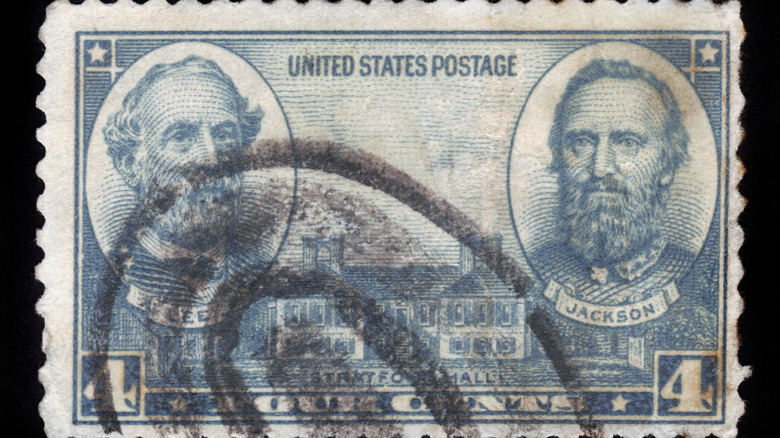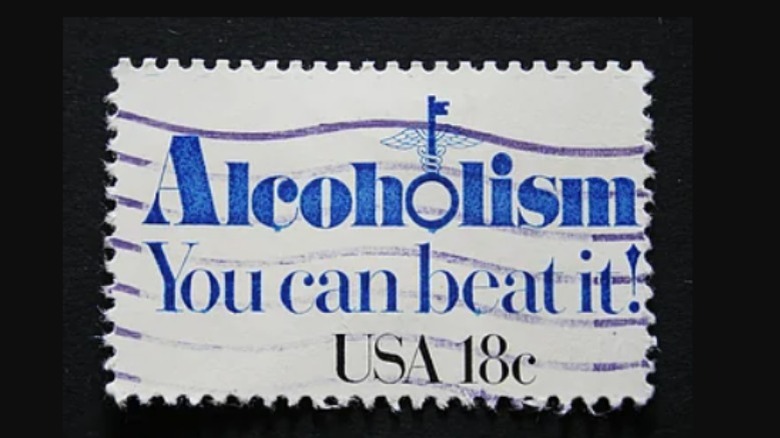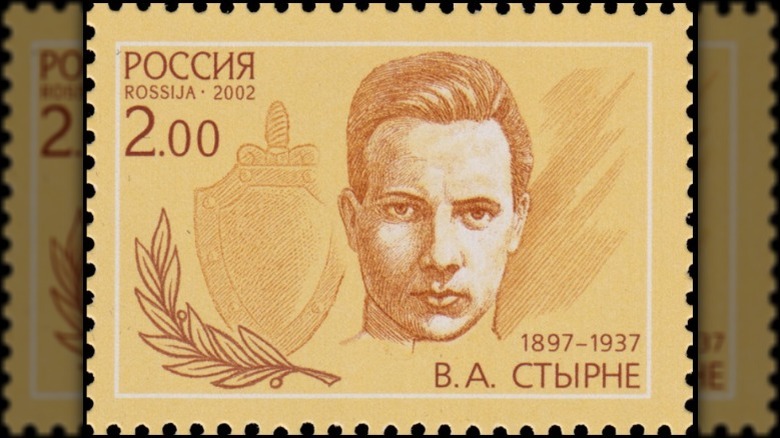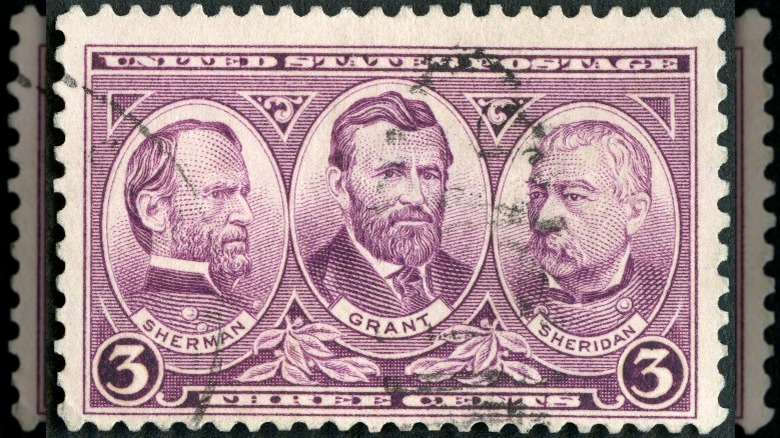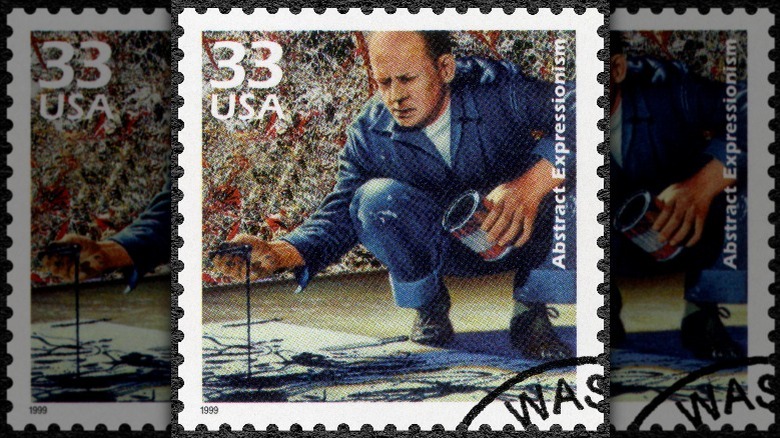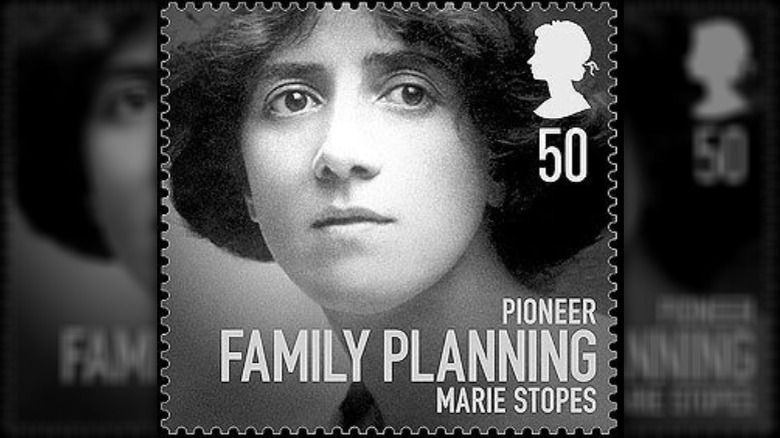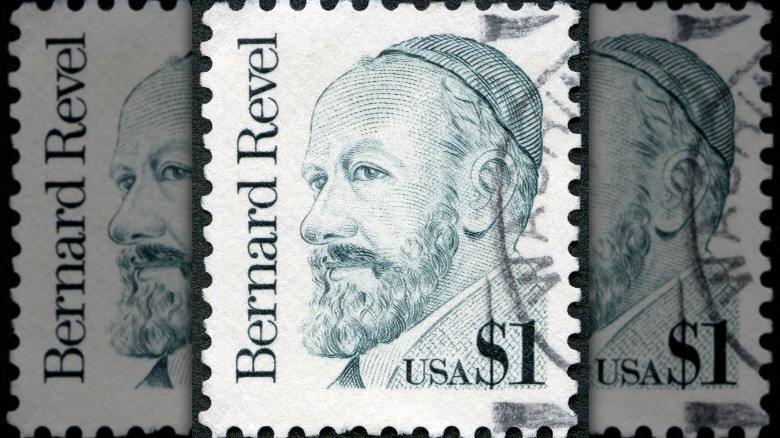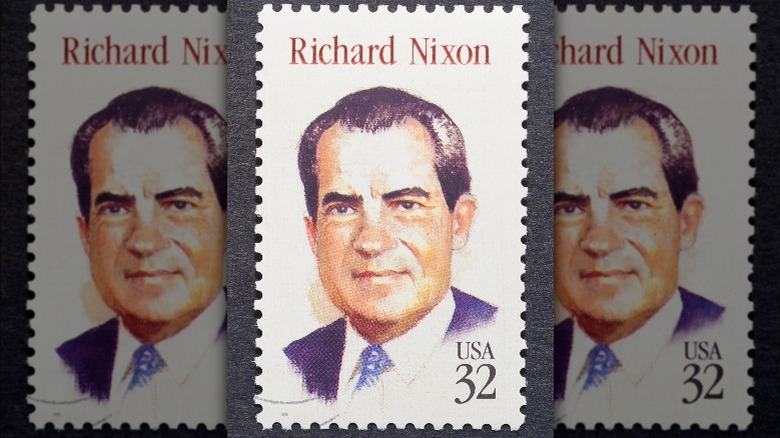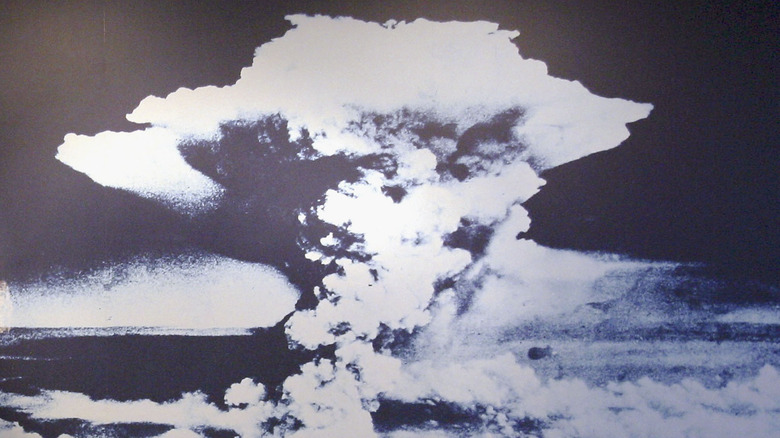The Most Controversial Postage Stamps Ever
Unless you are a stamp collector, you probably don't think about stamps too much, especially now that most daily communication is not done through snail mail. (And if you are a philatelist, you probably think about stamps ... too much.) But it's obvious even to the clueless that the images on stamps change from time to time. So how does that happen?
It turns out, in the U.S., it's down to the Citizens Stamp Advisory Committee. The group meets numerous times a year to discuss their favorites of the tens of thousands of stamp ideas sent by regular people. But it's not just about picking the ones they think are pretty; there are also rules for what can and can't be pictured on a stamp. For example, the rules used to be a person had to be dead 10 years before they could be commemorated on a stamp, then it was lowered to five, and finally, in 2011 the Post Office announced living people would be honored with them.
But even with the many different stages a stamp has to go through before it is selected and produced, sometimes things go wrong. Not just the U.S., but countries around the world have chosen to release stamps with images that offended either their own citizens or even ruffled international feathers. These are the most controversial postage stamps ever.
Ukraine's Crimean Bridge explosion stamp
As of this writing, Russia's invasion of Ukraine which began in February 2022 is still ongoing. No one knows what will happen, but considering what experts were saying way back at the start, Ukraine had more than held its own. Vladimir Putin and many in the international community expected Kyiv to fall to the Russian military within days, but immediately there were incredible signs of resistance. One example was when a few dozen soldiers stationed on a small island refused to surrender to a Russian warship, instead telling those onboard to "go f*** yourself," seemingly in the face of certain death. (It was later reported the men were taken captive.)
According to The Guardian, that moment was made into a stamp in Ukraine quite quickly and helped to keep the population motivated in the face of danger. But this was not the most controversial stamp of the campaign.
On Putin's birthday, an explosion damaged the Crimean Bridge, which he'd built at a cost of billions of dollars after annexing Crimea in 2014. It was a very in-your-face symbol that Russia would now forever be connected to Crimea – literally. The Telegraph reported that just hours later, Ukraine released a stamp showing two figures who looked just like Jack and Rose from "Titanic," standing on the edge of the destroyed and broken bridge. Again, this was mere hours later. Considering the Ukrainian government hadn't even claimed responsibility for bombing the bridge, many thought the stamp was released suspiciously quickly.
Pakistan's Burhan Wani stamp
When Ukraine produced a stamp based on its attack on a Russian bridge, the two parties were at least in open conflict with each other. Now imagine if, instead, after lots of diplomacy, time, and effort, the two sides had come together to work on a peace deal – and that's the moment Ukraine picked to debut the stamp. You can see why that would be an even bigger problem.
But that is pretty close to what happened with India and Pakistan. The two countries have been unhappy neighbors for decades. When Imran Khan became prime minister of Pakistan in 2018, he openly signaled he was willing to start working out his country's differences with India, according to The Washington Post.
However, a planned meeting between the foreign ministers of the countries was suddenly canceled by India for two reasons: the killing of a border guard, and a set of stamps. See, a couple of months earlier (shortly before Khan was elected), Pakistan had issued a set of 20 stamps in honor of "Kashmir Martyr's Day." This was meant to commemorate the deaths of Pakistanis fighting in that area. The problem was, India also claims Kashmir, and they consider the people who were being honored on the stamps terrorists, including Burhan Wani (pictured). To an American, it would be like negotiating with the Taliban right after they released a stamp honoring Osama Bin Laden. However, Pakistan obviously rejected their fighters being labeled terrorists by India, and the hope for détente crumbled.
Alcoholism awareness stamp
Unless you are extremely paranoid (and you should be, they are watching you right now), you probably don't think that those sending you correspondence are trying to deliver secret messages through the stamps they choose for the letters. Your electric company just bought those American flag forever stamps in bulk, they aren't trying to root out communists with them.
However, there was at least one stamp that had a lot of people wondering if the recipient was trying to say something a bit pointed. According to Old Bid, in 1981, the U.S. Postal Service issued a stamp reading simply: "Alcoholism: You can beat it!" The intent behind the stamp was great; after all, alcoholism isn't talked about openly enough today, let alone four decades ago. The stamp's release was accompanied by a large ad campaign to help get that conversation started.
See the problem? The post office didn't, at least not until they printed almost 100 million of them. As a spokesperson for the Postmaster, James Van Loozen told The Los Angeles Times in 1985, "We had a stamp that said 'Alcoholism: You Can Beat It,' and it didn't sell. Apparently, people felt that putting that stamp on a letter was suggesting to the person receiving it that he has a drinking problem. You have to be careful what you put on stamps."
If you or anyone you know needs help with addiction issues, help is available. Visit the Substance Abuse and Mental Health Services Administration website or contact SAMHSA's National Helpline at 1-800-662-HELP (4357).
Stalin's henchmen stamps
The fog of time can obscure events and people in history. If you personally lived under a brutal dictator, you would never allow a good word to be said about them in your presence, while your great-grandchildren might see the ruler's actions in more shades of gray.
So it is in Russia when it comes to Joseph Stalin. According to "Empires Apart," by the 2010s, only 30% of Russians thought Stalin's actions were mostly awful. This helps explain why, in 2001, the government released a set of stamps honoring some of Stalin's henchmen. "Empires Apart" says these were not just your run-of-the-mill mean guys but "some of the greatest mass murders of modern times." These dudes — who were being officially honored with their own government-issued stamps, remember – had resumes that are soaked in blood: Sergei Vasilyevich Puzitsky (pictured), for example, orchestrated the extermination of 500,000 members of the ethnic minority Cossacks. Or, as Russia's chief stamp designer put it (per the BBC), "We're starting to realize in Russia that not everything in our history was bad. These were honest, decent citizens. Some of them were even geniuses. They helped protect our country and our people."
It's also worth pointing out that Vladimir Putin came to power in 2000, so those people who, as the BBC reported at the time, were sounding the alarm at what these stamps meant and what they portended were like philately Cassandras. Honoring mass-murdering secret police is a not-subtle way of announcing how you plan to rule.
Civil War generals stamps
The Civil War ended in 1865, but in the 1930s, it managed to flare up again, albeit that time with far fewer casualties and far more angry stamp collectors.
Over the course of 1937-38, the U.S. Postal Service released 10 stamps mean to commemorate some of the country's big-name military heroes, according to the Mystic Stamp Company. If you live in a state that was once part of the Confederacy, and you look at the stamp above, you will immediately see the problem. That guy on the left is William Tecumseh Sherman, and the South hates him. He took Atlanta during the Civil War and on his "march to the sea" enacted what in the 20th century would become known as total war, per the Bill of Rights Institute. Linn's Stamp News says that while Sherman had been honored on stamps several times before, it wasn't until this release that anyone seemed to notice. There were threats to boycott the stamp, and Georgia and South Carolina's legislatures went so far as to pass official resolutions against it. Despite all this, the stamp sold well in the South, with some people buying them for the chance to finally "lick" Sherman.
A stamp featuring Confederate general Robert E. Lee was already planned for release after the Northern generals one, but that didn't placate angry Southern stamp collectors for one big reason: Lee, a three-star general, was depicted with only two stars on his collar. This was interpreted as a blatant attempt to insult him, and thus all proud Southerners.
Jackson Pollock's and Robert Johnson's cigarette-less stamps
By this point, you've probably heard smoking is bad for you. Shocking, right? But back in the day, people smoked a whole lot, to the point that some famous people were hardly ever pictured without a cigarette in their hand or mouth. But as society accepted smoking did horrible things to smokers and even those people around them, views on the acceptability of depictions of smoking in media changed drastically. This included those people pictured on stamps, which somehow managed to be controversial more than once.
According to The New York Times, when blues guitarist Robert Johnson was honored by the U.S. Postal Service on a stamp in 1994, pro-smoking groups (a thing that apparently used to exist) were furious the cigarette he'd been holding in the original photograph was removed from the image in stamp-form. As a spokesperson for the Postal Service explained at the time, it was edited out "because they didn't want the stamps to be perceived as promoting cigarettes."
Still, for some reason, this same controversy came up again just five years later, this time over the removal of artist Jackson Pollock's cigarette on a stamp honoring his work (pictured). The illustrator who adapted the original photo – in which Pollock is clearly smoking — for the stamp told The Baltimore Sun, "It was an instruction to me: Remove the cigarette." Even art lovers were angry, as the National Postal Museum records, because Pollock was so synonymous with smoking, it was like changing who he was.
The Marie Stopes stamp
In the past, men have hugely outnumbered women when it came to who was considered worthy to honor with a stamp, so the U.K.'s Royal Mail had good intentions when it released a set of stamps in 2008 that highlighted six women who'd changed the country for the better. While all of them had courted controversy in their time, one of the women chosen was a bit too controversial for the public: Marie Stopes.
While The Guardian explains that Stopes wrote the first widely-available book on family planning and opened the first free clinic to offer those services in 1918 and 1921, respectively, she was also a big believer in eugenics and the idea of a master race. By putting her on a stamp, the Royal Mail managed to anger both those who were anti-choice and those who identified as feminists.
The charity Stopes founded still exists, and in 2008 they brushed off the negative response to the stamp, saying, "Controversy she may have courted, but it is difficult not to be astounded by Marie Stopes' achievements." However, by 2020, the organization had changed its tune a bit. After a decade and a half of social change and worldwide discussions about race and implicit bias, defending Marie Stopes was no longer remotely possible. The BBC reported that the charity changed its name to MSI Reproductive Choices after admitting that the good parts of her legacy couldn't be separated from the absolutely horrible stuff.
The Bernard Revel Star of David stamp
The designs of postage stamps have to go through layers of committees before being approved, with every aspect of the design scrutinized. However, there is one place all of that can go out the window, and it's the person that actually etches the final design before production. If that person was subtle enough, they could alter the approved stamp, and no one would notice.
That's exactly what happened in 1986 when the U.S. Postal Service released a stamp of Bernard Revel in honor of Yeshiva University's centenary, according to The New York Times. The artist behind the design was Kenneth Kipperman, who was one of only 16 people allowed to create final designs. He'd finalized it a year before, and unknown to anyone, Kipperman – who was Jewish – had added a Star of David to Revel's beard. You can see it above, where the corner of his mustache meets his beard. No one noticed this change until 1987, when Linn's Stamp News tipped off The Washington Post. It wasn't clear what punishment was called for, since as far as anyone could tell, this was the first time an artist had altered a stamp image on purpose. The Postal Service made clear that while it was "not an uncommon thing for engravers to somehow personalize their work," it was definitely not allowed.
By that point, though, Kipperman had bigger problems. Only a few months before the Star of David was discovered on the stamp, he threatened to blow up the site of the Holocaust Museum in Washington, D.C.
The Richard Nixon memorial stamp
When it comes to the question "who was the worst president in U.S. history?," there are plenty of legitimate answers you could give. And it's a spirited debate, since just as people have wildly different political views, they consider different presidents to be failures. Historians rank them occasionally, and usually, presidents shift a couple of spots up or down each time.
But one president almost everyone can agree really screwed up when it came to being in charge is Richard Nixon. He is still the only president to resign, a decision he made since he was being faced with almost certain impeachment and removal from office for his involvement in Watergate.
But the thing is, presidents get honored on U.S. stamps. And like it or not, that included Nixon. Many people did not like it, and made that clear. According to The New York Times, Nixon died in 1994, and the Postal Service proceeded as they always did when a former commander-in-chief died, and began the process of designing a Nixon stamp. When the head of the House Post Office and Civil Service Committee learned this, he sent them a letter saying, "The logic of honoring this disgraced President escapes me. He lied to the American people. He lied to the Congress." A Postal Service representative replied, "We appreciate his comments, but we plan on going ahead with the stamp." The stamp did come out, and some enterprising mind designed envelopes that, when the stamp of Nixon's head was added, made it look like the ex-president was behind bars.
The Brontosaurus stamp
When Pluto was demoted from a planet in 2006, people of a certain age were sad but unsurprised. They had been through this all before, when they were informed that one of the dinosaurs they had learned about as children was no longer to be called a brontosaurus but an apatosaurus. As The New York Times explained, the same type of dinosaur was discovered twice, and once paleontologists realized the mistake, they agreed the name assigned the first time should be used exclusively. The brontosaurus name was retired.
Just like Pluto diehards, in 1989, the U.S. Postal Service decided it didn't care what the so-called "scientists" with their "facts" and "degrees" said. According to The Washington Post, when they issued a set of stamps highlighting four dinosaurs, they labeled one the brontosaurus – even though they absolutely knew beforehand that it was wrong. Yet they declined to change the name since "brontosaurus was more familiar to the general public" than apatosaurus.
As you might expect, that excuse didn't fly with the scientific community. Jack Pierce, chairman of the Department of Paleobiology at the Smithsonian Museum of Natural History, said the decision "suggests that the Postal Service cares little for the accuracy of the stamps they issue and they prefer 'cartoon' nomenclature to scientific nomenclature." He was hardly the only scientist to go on record with a complaint, as newspapers got so many quotes from them they must have been tripping over each other to denounce the stamp.
The A-bomb stamp
No one would argue the end of World War II was a momentous moment. In 2020, Berlin (although not the rest of Germany) even made V-E Day a holiday in celebration of the country being liberated from Nazi rule, according to the BBC. In the U.S., where V-J Day is more commonly celebrated, there are still a million ways one could honor the end of the war on a stamp with a meaningful, thoughtful image that would show tact to those on all sides.
Instead, the U.S. Postal Service decided to put a mushroom cloud on a stamp. Like, one of the actual mushroom clouds from one of the nuclear bombs the U.S. dropped on Japan.
For very obvious reasons, according to The Chicago Tribune, there was an immediate backlash to the planned stamp once it was announced in 1994. Especially from, you know, the entire country of Japan. The director of an organization for the survivors of the Hiroshima bombing said, "This is outrageous. It makes our blood boil with anger." It was reported that a high-ranking member of Japan's Foreign Ministry threatened a diplomatic response, but when asked about this directly, the department spokesperson simply deadpanned, "The Japanese people have a special feeling about this matter."
When the U.S. Postal Service subsequently canceled the production of the stamp, the Japanese prime minister made a statement thanking them for the decision, per The Washington Post.
